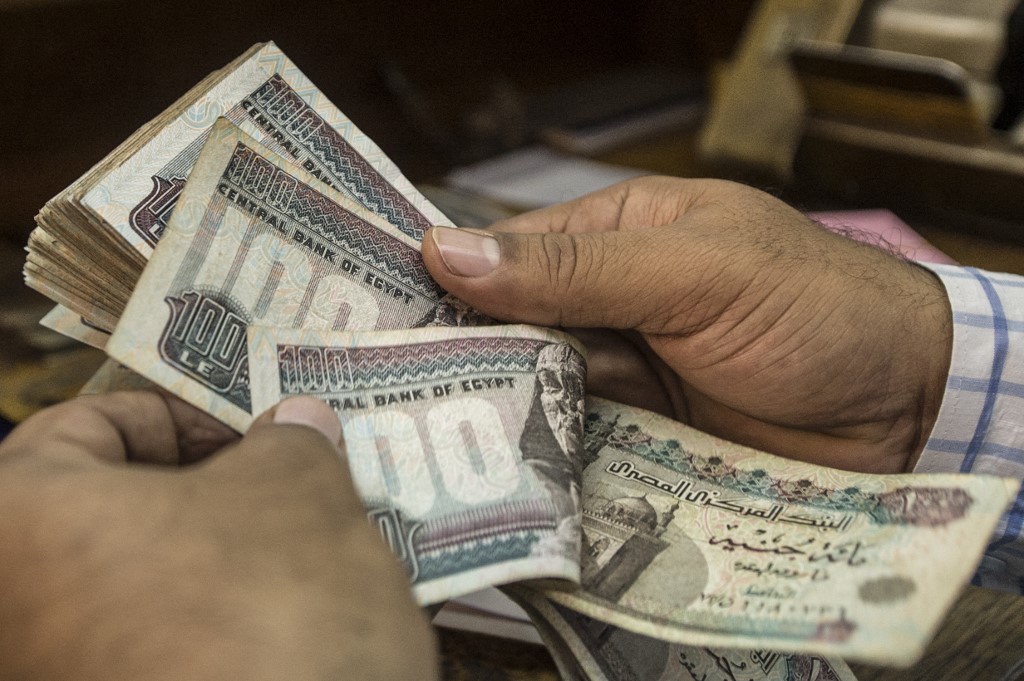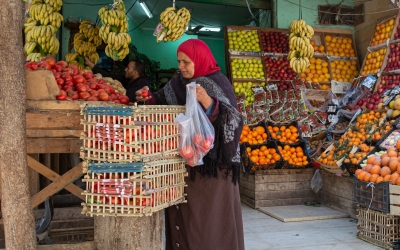Egypt's mounting debt crisis and economic woes explained
Egypt's debt, which has been sharply increasing in the past decade, is set to reach record levels by the end of the year.
With the markets still feeling the sting of the Covid-19 pandemic and now the ripple effect of Russia's war on Ukraine, this will only add trouble to the country's economy.
Recovery is set to take years, and tens of millions of Egyptians will be the ones to bear the brunt as food prices soar.
Here, Middle East Eye answers key questions on how Egypt's debt crisis unfolded and what it means for the country's economy.
What are the latest statistics on Egyptian government's debt?
By the end of the 2020/2021 fiscal year, Egypt's total debt reached $392bn. That includes $137bn in external debt, which is four times higher than in 2010 ($33.7bn). It also includes $255bn in internal debt, according to the Central Bank of Egypt, almost double domestic debt in 2010.
Figures released by the Daily News Egypt last week also revealed that the government is expected to borrow EGP 634bn ($34bn) from the local market in the last quarter of the 2021/2022 fiscal year.
External debt has been growing rapidly since President Abdel Fattah el-Sisi came to power in 2014. It stood at $46.5bn in 2013, then declined to $41.7bn in 2014 before surging in the following years, reaching $84.7bn in 2016, $100bn in 2018 and $115bn in 2019.
The ratio of the foreign debt to gross domestic product (GDP) is now 33.9 percent, which is relatively within safe limits according to international standards, which consider the ratio safe so long as it is below 60 percent.
However, when added to domestic debt, $79.4bn towards the end of the 2012/2013 fiscal year and now $255bn, the ratio of the total debt to GDP becomes 89.84 percent, significantly higher than safe limits.
In 2021, Egypt ranked 158th of 189 countries in the ratio of debt to GDP and 100th in debt per capita.
In January, the government debt-to-GDP ratio was 91.6 percent, up from 87.1 percent in 2013. The government says it hopes to reduce the total debt-to-GDP ratio to 85 percent in the coming three years.
However, as a goal this appears to be difficult to fulfil, given Cairo's plans to borrow an additional $73bn through bond sales this year.
Most of the external debt between 2013 and 2022 came from the sale of bonds in the international market. It also came from borrowing from international institutions, such as the International Monetary fund (IMF), and international banks.
Most of the internal debt was incurred because of government borrowing from local banks.
According to the rating company Standard & Poor's, Egypt is set to overtake Turkey as the largest issuer of sovereign debt in the Middle East.
The IMF has offered the Sisi government $20bn in loans since 2016, and Cairo has requested another loan since the onset of the Russia-Ukraine war.
IMF loans to Egypt since 2016 are significantly higher than the IMF's quota, and accordingly incurs an interest rate surcharge, according to a report by the Project on Middle East Democracy (POMED). The country has become the IMF's largest client after Argentina.
Egyptian economists express concerns that most of the debt will go towards serving older debt or repayments.
"The new financial resources need to create returns that help the state to repay the debts and the interests," Egyptian economic analyst Mamdouh al-Wali told Middle East Eye. "We need to use the loans in the production of commodities and services, not in the repayment of debts."
Apart from its ever-growing debt, the government has spent the bulk of its available revenues in recent years on megaprojects that "have a symbolic rather than economic value," according to the POMED report by Robert Springborg.
The projects include "the $58bn new administrative capital in the desert outside Cairo; weapons acquisitions whose exact value is unknown but which have placed the country among the world's top five arms purchasers; a $25bn nuclear reactor to produce power in a country with an electricity surplus; an $8bn expansion of Suez Canal capacity that has yet to generate a noticeable increase in transit dues, rising to only $5.8bn in 2020 from $5.6bn in 2017."
Overall spending in the 2020/2021 budget was $93bn. Out of this, $30.7bn went to servicing debt.
Coupled with a huge amount of money that goes to paying the salaries of the nation's more than six million civil servants ($18.2bn in the 2020/2021 budget), this leaves the rest of the budget to cover health, education and other services, and development.
Economists expect Egypt's foreign and domestic debt to keep increasing in the coming period for a number of reasons.
The war in Ukraine has deprived Egypt of an important source of national income, namely tourism, as almost a third of tourist inflows in recent years came from Russia and Ukraine.
In 2019, the tourism sector brought in $13bn in revenue.
The war is also forcing Egypt to pay more for its imports, most importantly wheat, almost 80 percent of which came from the two warring countries in 2021.
Tough measures following Russia-Ukraine war
On 21 March, Egypt raised the interest rate by 100 basis points and devalued its currency by 14 percent in the aftermath of Russia's invasion of Ukraine. The aim was to curb foreign capital outflows, stabilise the exchange rate of the Egyptian pound and prevent overall debt from growing.
However, these moves have caused food prices in the local market to shoot up, bringing in more suffering for tens of millions of people in a country where almost 70 percent of the population of more than 100 million depends on food rations.
Meanwhile, raising the interest rate and the currency depreciation have not prevented foreign capital from escaping to other markets.
This is why Egypt has invited oil-rich Gulf countries to come to its rescue, including by depositing billions of dollars in its central bank to prop up international reserves and by pouring investments into the Egyptian market.
Arab allies are, however, acquiring some hard assets that already exist and are functioning and profitable, not launching new projects that could increase national production. This is raising concern among Egyptians who fault the government in letting these important existing assets get into foreign hands, even as they bring in revenues for the Egyptian government.
Saudi Arabia has already deposited $5bn in the Central Bank of Egypt. It has also said it would invest an additional $10bn in the country in the coming period.
The United Arab Emirates has invested $2bn in the purchase of the government's share in several projects, including a major bank and a fertiliser company.
Qatar said it would invest $5bn in Egypt in the coming years, without specifying the type of investment.
What is happening to foreign reserves?
The war has also impacted foreign reserves, which were just short of $41bn at the end of February this year, then dropped by almost $4bn in March to $37.082bn.
The Covid-19 pandemic had already put the brakes on the growth of Egypt's foreign currency reserves before the war in Ukraine made things even worse, as tourist inflows from Russia and Ukraine slumped and the cost of food imports rose, including in the form of higher transport and insurance fees.
'We will need to encourage Egyptian workers in other countries to maintain the remittances they send home'
- Karim al-Omda, Economy expert
Economists have called for reduced imports, increased exports, and new tourism markets to be found to compensate for the losses caused by the war in Ukraine.
"Apart from these measures, we will need to encourage Egyptian workers in other countries to maintain the remittances they send home," international economy expert Karim al-Omda told MEE. "We also need to produce more and better in order to increase our exports, whose value is far from satisfactory."
Remittances from Egyptian workers in other countries amounted to $31.5bn in 2021.
Economists like al-Omda expect remittances to increase this year, with Gulf states, where millions of Egyptians work, making gains from the higher oil price caused by the war.
Egypt's commodity exports were over $30bn in 2021.
What is the impact on the population?
The economic impact of the war in Ukraine is expected to be felt for many years, and, with any recovery likely to be a long way ahead, this will translate into enduring suffering for tens of millions of Egyptians who already find it difficult to satisfy their basic needs.
Food prices have almost doubled, and some Egyptian families have had to drop one basic item after another because of these high prices.
On 12 April, President Sisi said the current crisis may last for a long time, and he asked government officials to make efforts to rein in commodity price increases.
"As state officials, we need to be present on the ground to listen to people and control the prices," he said.
The annual inflation rate jumped to 12.1 percent in March, up from 4.8 percent in the corresponding month last year, according to the government.
Urban inflation rose to 10.5 percent in March from 8.8 percent in February, the government also said, noting higher prices for food and beverages, and increasing costs in transport, education, hotels and restaurants.
Economists are suggesting a number of solutions to reduce pressures on ordinary people, including boosting the amount of commodities on offer, imposing tighter controls on the market and expanding social protection for the poor.
"It is also important to bridge financing gaps in ways that stabilise the exchange rate of the Egyptian pound," economist Walid Gaballah told MEE. "Egypt also needs to keep moving ahead with its structural reforms to rein in imports and increase its exports."
Middle East Eye propose une couverture et une analyse indépendantes et incomparables du Moyen-Orient, de l’Afrique du Nord et d’autres régions du monde. Pour en savoir plus sur la reprise de ce contenu et les frais qui s’appliquent, veuillez remplir ce formulaire [en anglais]. Pour en savoir plus sur MEE, cliquez ici [en anglais].






